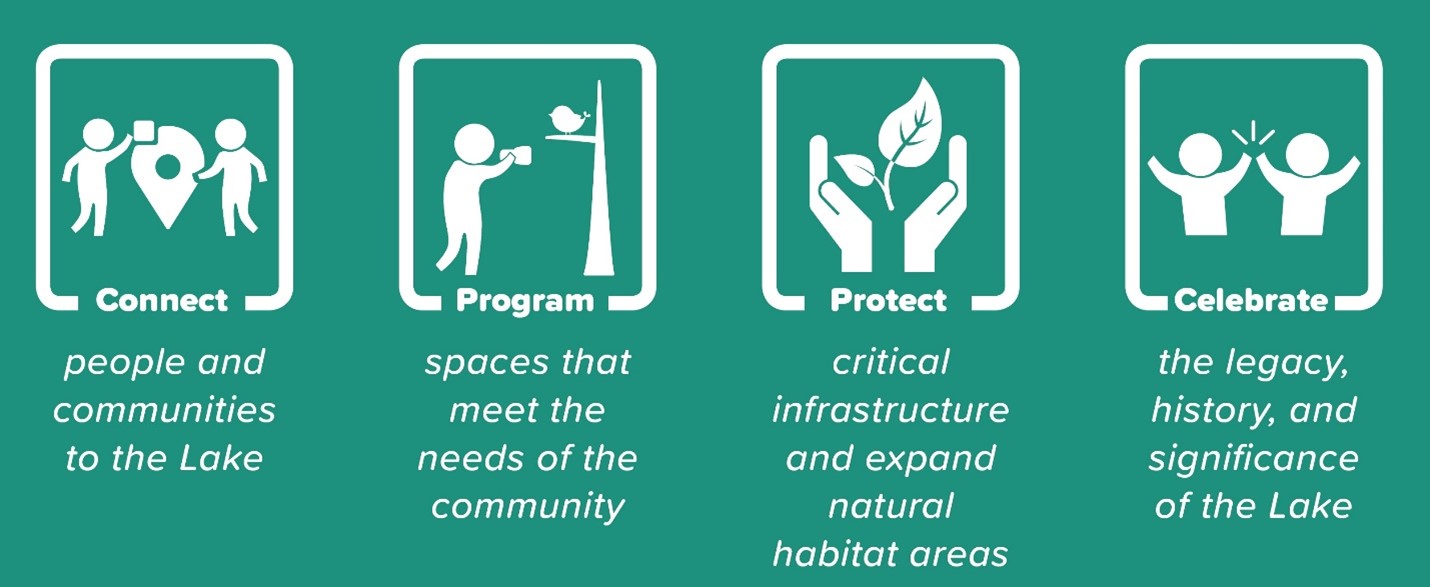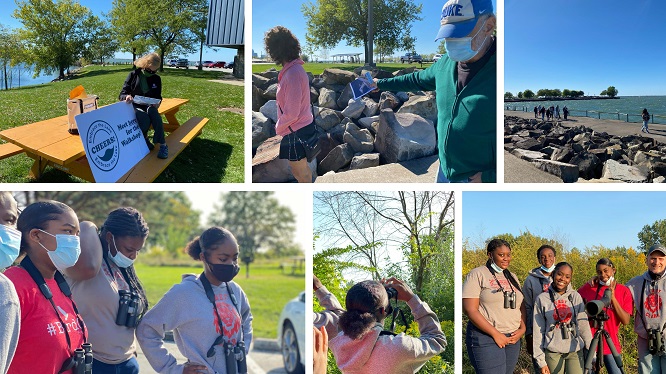
Case Study: Cleveland Metroparks
Cleveland Harbor Eastern Embayment Resilience Study (CHEERS)
Table of Contents
- Key Information
- Transferable Strategies
- Project Overview
- Challenges and Solutions
- Print this Case Study
Key Information
| Project Type | Site assessment and preliminary design | ||
| Theme | Outreach and engagement: Cleveland Metroparks needed to consider how to engage surrounding neighborhoods and residents in restoring Lake Erie’s eastern shorefront. They worked closely with community-based organizations and stakeholders to conduct virtual and in-person outreach activities and develop multilingual engagement materials for all ages. |
||
| Keywords | Stakeholder engagement, community resilience, shoreline adaptation, coastal recreation, lakefront restoration | ||
| Organization (Type) | Cleveland Metroparks (Local government organization) | ||
| Award Amount1 and Year | NFWF Award: $125,000 | Match: $126,000 | Award Year: 2019 |
| Project Contacts (as of 2022) |
Sean McDermott, Chief Planning and Design Officer, sem1@cleveleandmetroparks.com Kelly Coffman, Strategic Park Planner, kbc@clevelandmetroparks.com Kristen Trolio, Grants Manager, kmt@clevelandmetroparks.com Freddy Collier, Director of City Planning, City of Cleveland, fcollier@city.cleveland.oh.us Mary Morton, Consultant and Project Manager, WRT, mmorton@wrtdesign.com |
||
| Location | Cleveland Harbor, Ohio | ||
| Partners | Cleveland Port, Ohio Department of Natural Resources, City of Cleveland, Ohio Department of Transportation | ||
| Multimedia and Additional Links2 |
|
||
1 The award amount does not necessarily reflect the total project cost. The match amount is based on the project proposal information. 2 Disclaimer: The opinions expressed in the multimedia and additional relevant links are those of the project team and their partners only and do not necessarily reflect the views of the National Fish and Wildlife Foundation (NFWF).
Transferable Strategies from this Case Study
- Promote multi-partner collaboration: For restoration projects in public areas, it is important to involve and understand the needs of local and regional government agencies, nonprofits, businesses, community-based organizations, and other local stakeholders. Mechanisms such as virtual and in-person workshops, coordinating committees, and advisory teams can help ensure meaningful engagement and feedback from partners throughout a project.
- Engage community-based organizations: Collaboration with community-based organizations can help ensure community needs are met. This coordination can help identify equitable project outcomes that will serve communities and protect their interests, while also balancing habitat and ecosystem protection project goals.
- Use a wide array of accessible outreach tools: For projects that seek to engage diverse communities and residents, employing multiple outreach strategies can maximize the number of individuals engaged. In-person and virtual options in a variety of formats—such as informative hard copy and app-based signage, virtual meetings, walking tours, and scavenger hunts—ensure that individuals can learn about the project in the way that best suits their interests and needs. Translating communications materials into multiple languages can also boost engagement and ensure equitable access to information.
Project Overview: Cleveland Harbor Eastern Embayment Resilience Study
|
A yearlong planning process led by a government-community partnership marks the first step in transforming a hardened portion of Cleveland’s shoreline to a more natural state. Thanks to the Cleveland Harbor Eastern Embayment Resilience Study (CHEERS), the city now has a path forward for improving the resilience of Lake Erie’s eastern shorefront while providing benefits to the community and economy. CHEERS will connect people to the lake, create spaces that meet community needs, protect infrastructure and natural habitat, and celebrate the cultural significance and history of the lake (Figure 1).
Land use and industry have degraded the eastern embayment of Lake Erie in Cleveland, diminishing in-water and nearshore habitat. These changes have also increased the vulnerability of the surrounding communities to environmental and climate impacts, such as more intense storm events and shoreline erosion. Cleveland’s East Side communities are particularly vulnerable, with high poverty levels and many minority populations. CHEERS focuses on nature-based solutions, including the beneficial use of dredged sediments from the Cuyahoga River, to balance both economic and social needs while preserving the lake’s critical services for generations to come.

Challenges and Solutions
CHEERS was a fast-paced initiative that required strong coordination among the project partners and extensive input from local communities and residents to identify strategies that met their needs while protecting infrastructure and expanding natural habitat. The project team used multiple engagement and outreach strategies to overcome these challenges and develop a study that addressed the needs of varied stakeholders. It also found ways to innovate and adapt its tactics when the COVID-19 pandemic emerged.
press their preferred goals and projects for the lakefront. Video summaries and updates were also posted to the website for feedback. For in-person events, all participants had to wear masks, remain socially distanced, sign waivers, and follow COVID-19 protocols.
Coordinating Multiple Project Partners
Challenge:
Many organizations and partners were involved in CHEERS. For the five core partner agencies, coordinating the work of these diverse groups was challenging.
Solutions:
- Establish distinct project teams with clear responsibilities: The project team worked with two main groups of participants to develop the study. The first was a project team of the five core partner agencies and other agencies, interest groups, and community organizations. This team ensured the project met its goals and regulatory requirements. The second group was a stakeholder committee that encompassed additional interest groups, potential future partners, private businesses, educational and cultural institutions, and local representatives. The stakeholder committee coordinated outreach efforts to residents, helped mobilize local groups, and engaged the community in CHEERS.
- Streamline communication: CHEERS established a single point of contact for the five partner agencies and a single point of contact for the consultant team. The two project leaders had standing meetings to coordinate work with their teams and together facilitated the various levels of project participation.
- Identify and adapt to partners’ needs: The project team worked together to define the study’s goals, identify what each organization needed to accomplish, and determine how to leverage each other’s efforts effectively. Over the course of the project, the team hosted eight participatory workshops to discuss partner priorities and needs, project progress, and milestones achieved. The workshops were also important to help troubleshoot any problems that arose.
- Engage stakeholders in testing community outreach approaches and building consensus around priorities: The stakeholder committee helped the project team test outreach and engagement ideas before implementing them with community members. The committee held five online workshops designed to encourage dialogue around conceptual ideas. The committee used interactive tools, including online polling, to help build consensus around priorities. Virtual white board tools and virtual sticky notes provided a platform for live markups and design collaboration. Breakout rooms facilitated discussion for smaller groups, and the chat function helped memorialize feedback.
Adapting to Changing Working Conditions
Challenge:
CHEERS began right as the COVID-19 pandemic emerged, forcing the team to adapt to the changing working conditions of COVID-19 and the limitations the pandemic imposed on in-person engagement. The team had to determine new strategies for many of the in-person meetings and outreach events they had originally planned. In addition to the pandemic, the team also had to consider competing community priorities, such as voter registration and the 2020 census.
Solutions:
- Adjust project schedules to align with changing conditions: The team extended the project timeline through the second half of 2020 to acknowledge pressing community priorities, such as COVID-19 relief efforts and the 2020 census and voter registration efforts, in addition to CHEERS that partners were tackling. Project partners and stakeholders had additional time for review and comments, which helped inform early project concepts and prioritization, and resulted in the plan’s focus on community priorities and on representing local voices.
- Provide a suite of engagement options: The team developed a portfolio of techniques to keep everyone safe during the pandemic while ensuring broad community engagement. Having multiple strategies allowed residents to choose which options best met their needs and comfort level during the pandemic. For instance, community members could opt to attend web-based town hall meetings or take an online user survey to express their preferred goals and projects for the lakefront. Video summaries and updates were also posted to the website for feedback. For in-person events, all participants had to wear masks, remain socially distanced, sign waivers, and follow COVID-19 protocols.
Identifying Engagement Strategies to Reach a Diversity of Citizens
Challenge:
CHEERS strove to identify appropriate strategies for engaging the varied cultures and communities surrounding the eastern embayment.

Solutions:
|
- Ensure accessibility of outreach materials and approaches: The team provided all printed and survey materials in English, Spanish, and Mandarin to allow residents to learn about the site and share their opinions. Team members also strove to participate in existing events, like community festivals and monthly meetings, to help meet residents where they were and educate them about the project.
- Help communities connect to the environment: The team coordinated Embrace the Lake “walkshops” to provide community members with an opportunity to tour the study site, see and learn about their nearby ecosystems in person, and share their ideas for future uses of the area. The team publicized the walkshops through social media, partner networks, postcards, and posters. The team also posted informative signage along the shoreline with QR codes that allowed visitors to use their smart phones to learn more about the site and study. Residents who could not attend the in-person walkshops were able to explore the lakefront through virtual scavenger hunts. Participants could visit up to eight different virtual sites and complete tasks along the way. Those who completed at least one task were entered into a raffle for a local grocery store gift card.
- Collaborate with community-based partners: The team worked closely with four local community development corporations (CDCs) throughout all stages of the CHEERS process, from evaluating baseline site conditions to researching and designing surrounding preliminary restoration options (see box). The team held community engagement coordination meetings with the CDC partners to strategize ways to ensure any study area restoration projects would serve existing communities, maintain affordable housing, avoid resident displacement, and encourage equitable development.
Print this Case Study (PDF version)